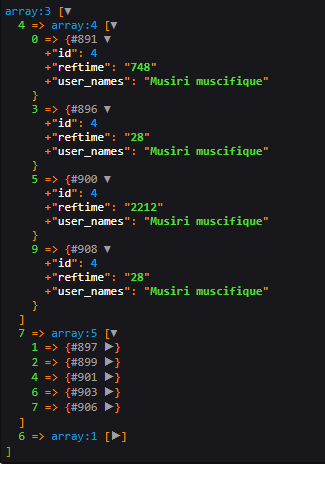

Exampleįollowing example demonstrates the usage of the localtime() function − Live Demo This function was first introduced in PHP Version 4 and, works with all the later versions.

PHP localtime() function returns an array representing the local time. Keys of an associative array are: tm_sec, tm_min, tm_hour, tm_mday, tm_mon, tm_year, tm_wday, tm_yday, tm_isdst If this value is true, the array returned will be associative with the components of a Unix time stamp as keys. In this tutorial, we will go through the following date/time functions to get the current timestamp.

#Php associative array timestamp free
That means that if you sort the strings, the dates will be in the correct order. If a timestamp is provided the function returns an associative array containing date and time values for that timestamp, otherwise it returns date and time values for the local time. JSON / PHP Array Converter is a free online developer tool to convert between JSON data and PHP arrays. If this value is false the array returned will be normal array with integer index. sort(timestamparray) You don't need to convert to UNIX timestamps because the strings are in the standard 'ISO sortable date' format. This is a boolean value determining the type of the array returned. This is a integer value representing the Unix timestamp of the local time. Localtime($timestamp, $is_assoc) Parameters Sr.No \Drupal\Core\Datetime\DateFormatterInterface::formatTimeDiffSince() FileĬore/ lib/ Drupal/ Core/ Datetime/ DateFormatterInterface.php, line 115 ClassĭateFormatterInterface Provides an interface defining a date formatter.The localtime() function returns the local time in the form of an array, with different components of the time as elements of the array. \Drupal\Core\Datetime\DateFormatterInterface::formatDiff() String| \Drupal\Core\Datetime\FormattedDateDiffĪ translated string representation of the difference between the given
#Php associative array timestamp code
String will be the formatted time difference. If the key is found in cache, it then returns array ( timestamp. The following examples shows two ways of creating an indexed array, the easiest way is: Example Run this codeweek (name) Thursday month Month of the year (name) January 0 Timestamp 948370048. If FALSE and $timestamp is before the current request time, the result The Associative Array Returned by getdate() : getdate Date PHP. If TRUE (default) and $timestamp isīefore the current request time, the result string will be "0 seconds".

Instead, we could use the respective subject’s names as the keys in our associative array, and the value would be their respective marks gained. For example, to store the marks of different subject of a student in an array, a numerically indexed array would not be the best choice. ParametersĪ UNIX timestamp to compare against the current request time. Associative arrays are used to store key value pairs. 9 core/lib/Drupal/Core/Datetime/DateFormatterInterface.php \Drupal\Core\Datetime\DateFormatterInterface::formatTimeDiffUntil()įormats the time difference from the current request time to a timestamp.8.9.x core/lib/Drupal/Core/Datetime/DateFormatterInterface.php \Drupal\Core\Datetime\DateFormatterInterface::formatTimeDiffUntil().Same name and namespace in other branches


 0 kommentar(er)
0 kommentar(er)
